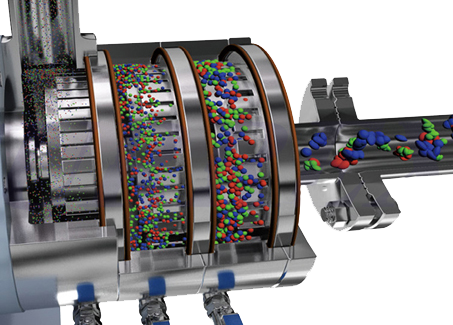Emulsifying machine plays an important role in industrial equipment mixing systems, especially in solid-liquid mixing, liquid-liquid mixing, oil-water emulsification, dispersion homogenization, and shear grinding. The reason why it is called an emulsifier is that it can achieve emulsification. The oil-water two-phase medium is thoroughly mixed to form an emulsion, which is divided into two types: water-in-oil or oil-in-water. To achieve emulsification, there are at least two requirements: First, strong mechanical cutting and dispersion, the water phase and the oil phase The fluid medium is simultaneously cut and broken into small particles, and then merged and merged to form an emulsion. The second is a suitable emulsifier, acting as a medium bridge between oil and water molecules. Through the action of its charge and intermolecular force, the oil-water mixed emulsion can be stably stored according to the time we need.
Nowadays, the application of the emulsifying machine is not limited to “emulsification”. Due to its unique shearing action, the pulverizing impact of the granules in the liquid is finally refined to the desired particle size, so that the solid matter is fully blended into the liquid. And a relatively stable suspension is formed, which is also called "dispersion". Of course, as with the emulsifier, the stability of the suspension can be enhanced by the addition of a dispersing agent. When a solid substance is completely dissolved by the liquid by contact with the liquid for a certain period of time, the small particles formed by the shearing impact will be dissolved by the liquid more quickly because the specific surface area is increased by many times.
When people get used to obtaining fine particles by high-pressure homogenizer (compression, high-pressure instantaneous release, jet impact), "fine" is equal to "homogeneous", so the emulsifier refines the material and the effect of full blending is also the process of "homogeneous". Therefore, we can also call the emulsifying machine as a homogenizer. At the same time, the emulsifying machine can also be called high shear emulsifier, high shear homogenizer, high shear dispersing emulsifier, high shear homogenizer, high shear homogenizer emulsifier.
The strength of the shearing action of the emulsifying machine directly affects the final fineness. After analysis, it is mainly related to the sharpness of the blade, the hardness, the rotor stator gap, the relative movement speed of the two cutting edges and the allowable particle size. Under the blade sharpness, hardness, rotor stator gap and allowable particle size have been basically fixed or do not want to change, then the relative movement speed of the knife edge is the most influential factor, which is expressed as the circumferential speed of the rotor (because the stator is still). If the line speed is high, the density of cutting or impacting on the radially flowing fluid is high, so the refinement effect is strong, and vice versa. But the line speed is not as big as possible. When it reaches a very high value, it will form a tendency to block the flow (just like the high-strength warrior can turn the sword to resist the incoming arrow), so the flow becomes very small, and processed material temperature is very high, and some materials will accumulate in turn, making the results unsatisfactory.
Is the stirring speed we usually say is the shear speed? As we known, the speed is divided into angular velocity and linear velocity. The shear velocity is of course the linear velocity, linear velocity = angular velocity × diameter × π, so why the speed (angular velocity) of the emulsifying machine used in industrial production is generally only 3000 rpm or 1500 rpm @50Hz, and the laboratory emulsifier speed is 10000 rpm or 280000 rpm, which takes into account the diameter factor, so that the shear line speed of the two is close, and the final effect is close. From another point of view, the laboratory is characterized by a small amount of testing. Therefore, the physical size of the rotating stator should be adapted to a small amount, and the diameter must be small. In order to compensate for the negative impact of the small diameter on the line speed, it is necessary to improve. The angular velocity of the rotor thus forms the "high rotational speed" of the experimental instrument.
It can be seen from the above that the rotational speed (angular velocity) of the emulsifying machine should be based on production capacity. At the current processing level and production economy. 2-pole motor is often used below 22 KW, 4-pole motor is used from 22-55Kw, 6-pole motor used exceeds 75 Kw.










